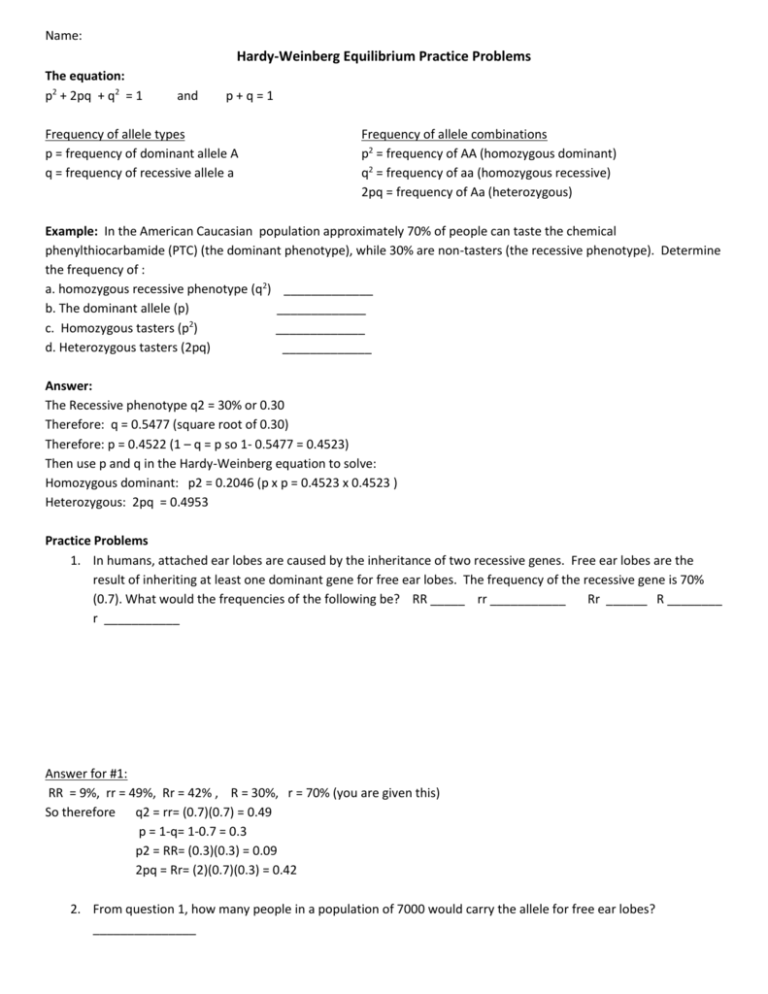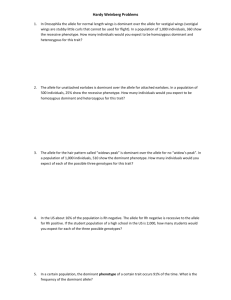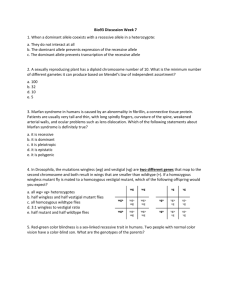Name: Hardy-Weinberg Equilibrium Practice Problems The equation
advertisement

Name: Hardy-Weinberg Equilibrium Practice Problems The equation: p2 + 2pq + q2 = 1 and p+q=1 Frequency of allele types p = frequency of dominant allele A q = frequency of recessive allele a Frequency of allele combinations p2 = frequency of AA (homozygous dominant) q2 = frequency of aa (homozygous recessive) 2pq = frequency of Aa (heterozygous) Example: In the American Caucasian population approximately 70% of people can taste the chemical phenylthiocarbamide (PTC) (the dominant phenotype), while 30% are non-tasters (the recessive phenotype). Determine the frequency of : a. homozygous recessive phenotype (q2) _____________ b. The dominant allele (p) _____________ 2 c. Homozygous tasters (p ) _____________ d. Heterozygous tasters (2pq) _____________ Answer: The Recessive phenotype q2 = 30% or 0.30 Therefore: q = 0.5477 (square root of 0.30) Therefore: p = 0.4522 (1 – q = p so 1- 0.5477 = 0.4523) Then use p and q in the Hardy-Weinberg equation to solve: Homozygous dominant: p2 = 0.2046 (p x p = 0.4523 x 0.4523 ) Heterozygous: 2pq = 0.4953 Practice Problems 1. In humans, attached ear lobes are caused by the inheritance of two recessive genes. Free ear lobes are the result of inheriting at least one dominant gene for free ear lobes. The frequency of the recessive gene is 70% (0.7). What would the frequencies of the following be? RR _____ rr ___________ Rr ______ R ________ r ___________ Answer for #1: RR = 9%, rr = 49%, Rr = 42% , R = 30%, r = 70% (you are given this) So therefore q2 = rr= (0.7)(0.7) = 0.49 p = 1-q= 1-0.7 = 0.3 p2 = RR= (0.3)(0.3) = 0.09 2pq = Rr= (2)(0.7)(0.3) = 0.42 2. From question 1, how many people in a population of 7000 would carry the allele for free ear lobes? _______________ 3. If 18 out of 50 lizards sampled has the recessive trait for short tails: a. what would the proportion of t alleles in the lizard population be? _____________ b. what would be the proportion of dominant genes? _____________ c. what percent of the population would be heterozygous? ______________ 4. Assume that the gene for wool color is dominant for the allele for white. If 25% of the sheep in a large population have black wool, calculate a. The gene frequencies of the two types of wool color:______________________ b. The percent of pure white sheep____________________________ c. The percent of heterozygous, or hybrid, sheep________________________ d. The number of white sheep in a population of 750_______________________ 5. Cystic fibrosis is a recessive condition that affects about 1 in 2,500 babies in the Caucasian population of the United States. Please calculate the following. a. The frequency of the recessive allele in the population. ___________________ b. The frequency of the dominant allele in the population. ____________________ c. The percentage of heterozygous individuals (carriers) in the population. _________________ 6. The allele for a widow's peak (hairline) is dominant over the allele for a straight hairline. In a population of 500 indiviuals, 25% show the recessive phenotype. How many individuals would you expect to be homozyous dominant and heterozygous for the trait? 7. The allele for a hitchhiker's thumb is recessive compared to straight thumbs, which are dominant. . In a population of 1000 individuals, 510 show the dominant phenotype. How many individuals would you expect for each of the three possible genotypes for this trait? 8. The ability to taste PTC is due to a single dominate allele "T". You sampled 215 individuals in biology, and determined that 150 could detect the bitter taste of PTC and 65 could not. Calculate all of the potential frequencies









